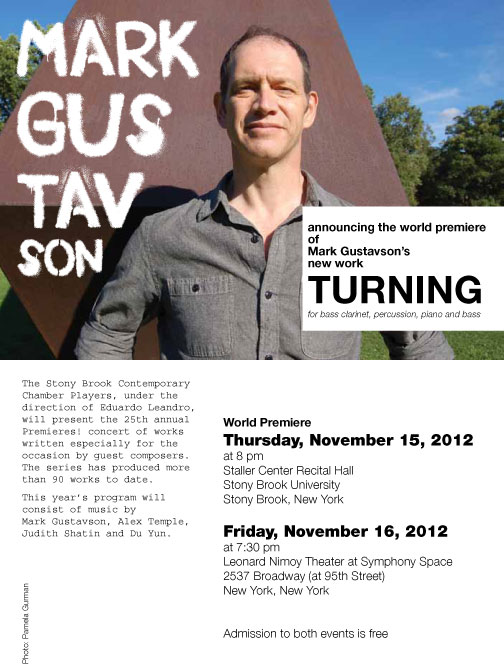
I hope to see you at one of these concerts.

I hope to see you at one of these concerts.
The Contemporary Chamber Players of Stony Brook University will premiere Turning on Thursday, November 15, 2012, 8:00 pm at Stony Brook University
AND
Perform again the next day, Friday, November 16th at 7:30 pm at:
Symphony Space
2537 Broadway at 95th Street
New York, NY
tel: (212) 864-5400
The Stony Brook piece is finished and is titled Turning for bass clarinet, percussion, piano and contrabass with a duration of 14 minutes.
I have received a commission from the Stony Brook University Department of Music to compose a piece for their Contemporary Chamber Players. It will be premiered this November at Stony Brook and a performance in Manhattan.
Last Friday I posted the first movement of my reed trio and today, as promised, I am posting the second movement, Song. The second movement is ten minutes long. However, this sound file only contains the first 4:30 of the movement and presents the first A and B sections.
Finished another song for the song cycle The Fisherman Songs, As Above, So Below using text from Thoreau’s Walden (The Ponds).
In 1994 I composed a work for oboe, clarinet and bassoon (known as a reed trio). The piece is in two parts. This sound file is the first part with a duration of five and one half minutes. This movement explores fragmented mercurial patterns that organically unfold from a moto perpetuo texture.
[audio:https://www.markgustavson.com/blog/wp-content/uploads/2012/01/mercury1.mp3|titles=mercury, part one]
The opening couple of measures presents two pieces of material, a chromatic noodling line that is broken into fragments, actually motives that will be explored later in the piece, between the parts and multiple octaves. The contrast between the smallest interval (the half step) and the largest interval (the octave) would be puerile if it weren’t for the unpredictability of how the noodling line is broken up and when the octaves interrupt the line. This seemingly desultory relationship actually creates an energy on the verge of being almost out of control. The idea of has interested me for almost as long as I have been composing.
I used this idea again in my woodwind quintet a year later but expanded. However, it is such a simple and fun idea that it could be used with many variations with any size ensemble.
Next week I will upload the second part, Song.
This clip is the opening of a piece I am working on for clarinet and piano. Mostly, the two parts are in separate meters, occasionally coming together. I don’t even have a title.
This is a midi realization of a fragment of a piece (2:00) I began working on in 2001 but is unfinished. Since then I have worked out this idea in different ways. The catalyst for this particular piece for violin and piano is the Wheel of Fortune. I am using a rondo of four sections representing: regno (I reign), regnavi (I have reigned), sum sine regno and regnabo (I shall reign). Most of the violin’s long sustains in the sum sine regno sections are played a quarter-tone low in relief to the piano chords to make them sound “sour”.